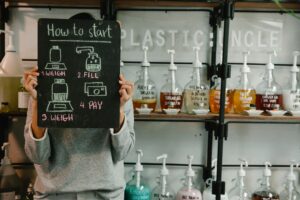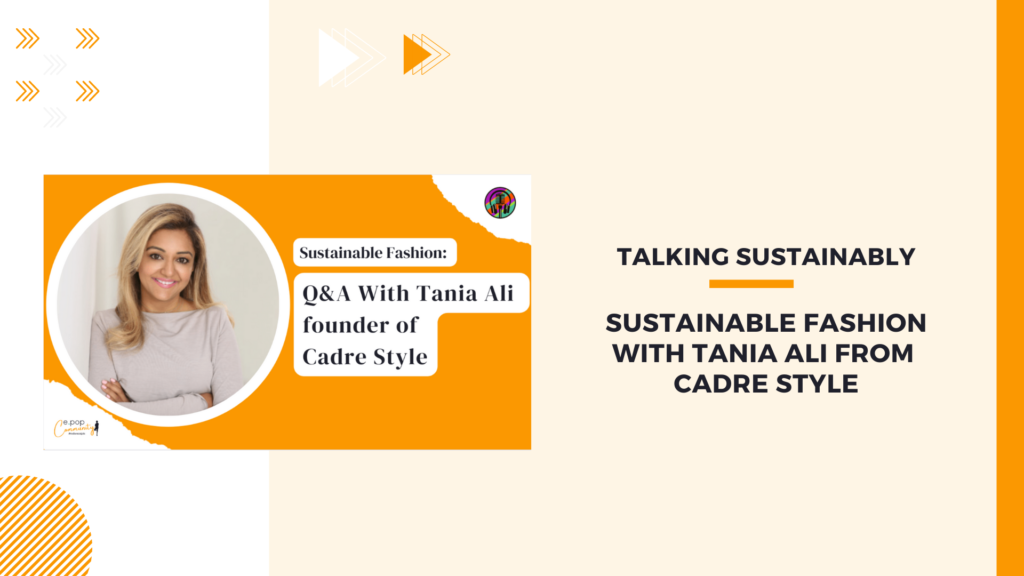Joined by our guest, Tania Ali, founder of New York-based sustainable fashion company Cadre Style, we discuss what it means to be green, how to adapt your business to a changing world, and the adaptability of small vs. established businesses.
In a very comforting moment, Tania reminds listeners that
“every small step you take matters. So do what you can, do what you remember. If you can remember it sometimes but don’t others, it’s ok. “
In this webinar Q&A with Tania Ali, the founder of the sustainable fashion platform, Cadre Style, we discuss:
- What is sustainable fashion
- How to reduce fashion waste
- Some common myths in the fashion business
- Small brands vs. big brands
- Changes that can be made to the fashion industry
- What can consumers do to be more sustainable?
Watch the webinar below or on our youtube channel.
About Cadre
Cadre is a sustainable fashion platform whose mission is to reduce the fashion industry’s impact on the environment by ensuring fair labor practices and curating the items their selection of fashion and accessories to use exclusively recycled, upcycled or biodegradable materials.
About Talking Sustainability
Sustainability can be daunting, overwhelming, and full of jargon. Talking Sustainably is a series of live discussions with entrepreneurs and companies focused on living more sustainably, either through their business models or personal lifestyles. We want to connect you with companies that are changing the way we live and talk about how they are making positive changes in the world. We’re here to fuel your own conscious lifestyle choices. Tune in to listen to conversations with founders of companies that are changing the way we use and consume products.
You can also watch it on our Youtube channel. You can find the whole transcription below.
About e.pop
Changing the way people and companies think about receipt and contactless solutions is what drives e.pop. Our mission is to build a community of forward-thinking companies and consumers unified in becoming carbon negative and ditch paper receipts altogether. We have started a movement to drive environmental change and innovation keeping all of us better organized and putting trees back where they belong.
Listen to our other episodes
- Listen Again: A conversation about sustainable fashion trends with Kelly Wang, founder of Rue Saint Paul
- Listen Again: Talking Sustainably -A conversation with Garik Himehaugh, Founder of sustainable retail platform Eco Stylist
Let Us Know
Liked this episode? Please share the link with your friends and contacts. 🙌
What did you think of these webinars? We’re keen to hear from you – get in touch with us on LinkedIn, Youtube, Facebook, or Instagram
Complete transcription of Sustainable Fashion with Tania founder of Cadre Style
How did Cadre get started?
I was a lawyer […] and was very concerned with what my carbon footprint was, what I could do to reduce waste in general and the more I explored the space the more I learned how to compost, non-toxic cleaning supplies, and non-toxic beauty. The part that took me the longest was finding sustainable clothing. I remember the first time I found, by accident, a pair of swim trunks that were made from recycled bottles and I was like ‘wow you can do that?!’ so it start this adventure and in my adventure, I thought ‘there’s a lot of amazing brands that are doing great things in the sustainability space, it just takes forever to find them.’ So, selfishly, I wanted a store that vetted products for me and just said ‘ hey, these are all sustainably made, this is what sustainability means to us. Here you go, shop your heart out. Everything here is good for the planet’.
And so, I came up with the concept and we’ve been working on it since August we are launching on Earth Day this year (April 22) and we are very excited to bring you access to sustainable brands from around the globe.
What does sustainability mean to you?
That’s something that I struggled with too. What does sustainability really mean? It’s not regulated. It’s kind of like what organic food was in the beginning. No one really knew.
So, we’ve come up with three overarching pillars, and then we have, within that some subcategories.
First of all for us: fair labor practices, because if we don’t sustain the people that are creating these beautiful pieces of clothing for us, there’s nowhere to go. They need to be given fair, living wages, no child labor, and safe working conditions.
Our second pillar is ethically sourced. So when you work with textile and garment manufacturers and you, as the brand, pull what you want to use to make your clothing, the way that material is sourced needs to not destroy the planet – in the way that you’re taking from the planet. Because the planet itself has given us everything we need. It can recycle itself. That’s what composting is. Biodegradable materials – you throw them back into the earth and they will take care of themselves. It’s self-cleaning.
Out third main pillar is sustainable materials. And what does that mean to Cadre; recycled materials, upcycled materials, biodegradable, and organic cotton. So, in order to be on our site, you need to use one of these four types of materials and then if you have additional features (like you use low-impact dyes or you use less water) we love that, we recommend it, but it’s really focused on what fabrics you’re using to be sustainable. Another part of what Cadre’s consumer journey involves is, at the end of your garment’s lifecycle (so when you’re done with your shirt) you can donate them to a textile recycling company and then the actual material continues to live on. It can actually get recreated into recycled cotton, recycled wool, whatever the case may be, and you continue to sustain that actual garment into new products. Or we can resell with a reseller and a shirt can continue to be used instead of going into fashion waste.
How can we reduce fashion waste?
There are two parts to fashion waste: one is what are the brands themselves doing? So, we are working with brands that use plant-based materials so they are biodegradable, thus reducing the waste from that product. There are companies we work with that use recycled woven materials. So, again, you can just reuse the same material reducing the product that goes to landfills. Then, there’s a company [we are talking to] that uses 3D printing. So, the garment itself is created in a way where there is no extra waste. And most of the brands that we’re working with have only two seasons that they show for so they’re not creating numerous collections. They’re getting consumers to think ‘hey, do I really need this much? And let’s be conscious of what we purchase.’
So there’s one side of reduction that happens with the brands. And the reason this is really important is [that] fashion itself is the second-largest pollutant on the planet. So there are about 92 million tons of fashion waste that go into landfills every year. Part of the problem is that we’ve created this fast fashion consumption culture. So, on the brand side, taking those out of their product line is one step. On the consumer side, it’s ‘when you make purchases do you need to buy the same shirt in 5 colors?’ but then there are now ways to buy products made from recycled plastic bottles, so they are taking waste out of the environment and reusing it. We went to a fashion show during fashion week this year, by a wonderful designer who was using ghost fish nets (fishnets that are left in the ocean) and making textiles out of that. Beautiful garments, it’s an amazing line. But that’s another way to reduce. Purchasing from a brand that actually takes the garbage out of the earth and makes you pretty clothing from it. Then, can you recycle what you’ve already used. Which is becoming the circular part. It’s becoming more common, while still very new. But if consumers can access a point where they can send their clothes to a textile recycler, that’s a way to reduce waste or to resell instead of throwing something out when you’re done with it and letting someone else wear it.
What are some common myths in the fashion industry?
I am very new to the sustainable fashion space. So, even for me, on my journey, I thought ‘ok, I have to be much more conscious about what I wear, not only from a fashion waste perspective but from how I help the planet’. I thought I was just going to be wearing tan, linen dresses. Just dress very plane, very crunchy, like there were no options.
Then, it is interesting because you start looking into things and Instagram starts showing you all these brands and everything starts popping up. So, what was fun for me was debunking that myth and finding these brands that were so on-trend. One of my favorite stories; I bought sustainably made biker shorts and a sports bra, a workout set. It was either Make the Label or Girlfriend collective. Both brands that I love. I went to work out at a Pilates class and this girl next to me was wearing a very similar outfit. In my head, this was proving my concept that you don’t have to change your style to be sustainable. There’s so much out there that looks exactly like what we want to buy right now. She commented after class “hey, we’re wearing the same outfit” and I was like ‘we are, but you didn’t even notice that mine was made using recycled plastic bottles and organic cotton.’ So it was very fun to live the debunking.
A month ago I bought this sweatsuit. Pants and a hoodie. And I have a friend who bought something very similar, actually looks pretty identical from a really high-end designer, and was so excited and said, wait I have the same thing. Just from a sustainably made brand. So that’s my favorite myth to debunk. It’s not what I thought it was going to be.
What Changes can be made to the fashion industry?
I think there’s a lot and the top-down change is very effective and part of what’s hard for consumers is that we didn’t choose to use a material that destroys the planet, that never degrades – like spandex will never go away – but we’re living with the consequences. There are many things [the industry] can do. Whether it’s reducing the amount of scraps they have when they create products. Can they reuse it? Can they make scrunchies out of it? Can they make another garment? Choosing dead stock material [like the company Reformation]. So they can be a lot more mindful of what textiles they’re using, especially using biodegradable textiles, organic textiles, things that will help the planet or have a longer life – that’s a change that they can make. Reducing their own waste. And then if they start to show less seasons, make less product, maybe less color variation – do we need a top in 15 different colors? Maybe it’s just 5 colors this season. I think those would really help. And people becoming more and more aware of what’s going on is going to force these companies to rethink it – and you see it already. Adidas definitely already has some sustainably made shoes, Nike has shoes with a biodegradable rubber perhaps. So these companies are exploring and I’m glad that they are because that’s where the bigger change will come and give consumers the place to make choices that are helpful to the planet.
Small vs. Big Brands – Do you see any difference in their sustainability efforts?
Smaller brands, because they start from scratch and there’s starting with this very mission-driven, purpose-driven idea, their whole business model is resting on something very different from a big brand that’s established, that has tons of employees and everything down to every dollar is calculated on their margins and what they’re doing and there are so many people involved. So I think it’s very different and harder to make a change in a bigger brand because there are so many different pieces at play. Whereas these smaller brands, and (Cadre included) are coming in fresh, we don’t have all these employees sitting there that these numbers are built on, that we feel like we may have to cut this or that. Our whole business model is aligned with the mission of helping the planet. With smaller brands, I also feel like they can experiment more because they don’t have as many dependencies. And the smaller they are the more testing they are doing right now because they don’t have a large audience, so it gives them the space to try different things and see what people really like.
What can consumers do to be more sustainable?
There are a ton of things. One of my favorite things I did were: I started to pay attention when buying skincare or groceries [….] I will now actively choose the brand that is using glass [as their container, as opposed to plastic]. And, again, nothing is 100% perfect because glass jars still have plastic lids but there’s less than an entire jar of plastic. I also ask [when buying a coffee] for them not to give me a plastic lid so that there is less plastic going into the planet. If I were super sustainable I would be using a reusable cup but the one thing I would like to say to everyone is: every small step you take matters, so do what you can do what you remember, if you remember it sometimes and don’t others, it’s ok, you’re at least trying. Even with clothes, it’s not about throwing away your entire wardrobe and starting again – that’s not helping, that’s just adding to the waste – so still use what you have and resell it or recycle it and when you go to purchase new items try to be more conscious and go to the brands that are more sustainable in their practices. Like Cadre!
You Might Also Be Interested In

Ecommerce Marketing and Consumer Privacy: The e.pop Advantage
The COVID-19 pandemic not only turned all of our lives upside-down, it brought to the surface many issues that had previously been bubbling below. For

The e.pop Digital Receipts App Step-by-Step Guide for Merchants
e.pop is a New York City-based startup developing e-commerce tools for brick-and-mortar and online retail businesses to reach and retain more customers and boost sales.

Is Your Ecommerce Marketing Strategy Optimized To Increase Sales And Retain Customers?
You may have already noticed it, but Millennials and Gen Z are pretty well-connected with their phones. Some might even say they’re glued to them.

How To Avoid Greenwashing—No Matter What You’re Marketing
What is greenwashing? It’s getting a big, green checkmark for an eco-effort that maybe isn’t as meaningful as it seems. It’s when a business takes

Green Guide: How to Open a Zero Waste Store
In our fast-paced, consumption-driven society, convenience is king. And it comes heavily packaged. While vacuum-sealed avocados and the dreaded box-within-a-box-within-a-box may make great viral photographs,

What does Sustainability Mean? Tips to run a low-impact business
Sustainability is becoming increasingly important. Not only for the environment but also for business! Businesses have the power to make a difference when it comes


Thank you for Listen Again: Talking Sustainably – Sustainable Fashion with Tania founder of Cadre Style